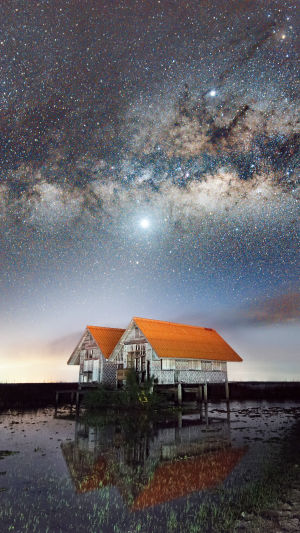"How big is the universe? And how old is it?" These are two of the most common questions asked by people gazing at the stars.
However, those new to cosmology may find themselves encountering a kind of confusion: on the one hand, they learn that the universe is 13.8 billion years old, but on the other hand, they are told that its maximum diameter can be up to 93 billion light years.
Because, based on their understanding, scientists must have found definitive evidence during the time between the Big Bang and now - photons produced by the Big Bang that was discovered by us after traveling for 13.8 billion years, much like how archaeologists use fossils to determine the age of Tyrannosaurus rex, which they have established lived 67-65 million years ago.
The universe is defined physically as all of space and time, collectively referred to as space-time, and its contents, including all forms of energy such as electromagnetic radiation, ordinary matter, dark matter, dark energy, and more. Ordinary matter includes planets, satellites, stars, galaxies, galaxy clusters, intergalactic matter, and other objects. The universe also encompasses the physical laws that govern matter and energy, including conservation laws, classical mechanics, relativity, and more.
Throughout history, numerous theories about the universe and its origin have been proposed. The ancient Greeks and Indians were the first to suggest ideas about the universe based on physical laws, rather than personal beliefs. Over the centuries, astronomical observations and improvements in theories of motion and gravity have led to more precise descriptions of the universe.
Modern cosmology began with Albert Einstein's 1915 general theory of relativity, which enabled quantifiable predictions about the universe's origin, evolution, and end. The vast majority of modern, accepted cosmological theories are based on general relativity, and more specifically on the Big Bang theory.
The Big Bang theory is the modern cosmological explanation for the universe's evolution. According to this theory, space and time emerged together after the Big Bang, which occurred 13,799 ± 0.21 billion years ago. As the universe expanded, the energy and matter that were initially present became less dense.
The initial accelerated expansion is referred to as the period of burst inflation, after which the four known fundamental forces separated. The universe gradually cooled and continued to expand, allowing for the formation of the first subatomic particles and simple atoms.
Dark matter accumulated, forming bubble-like structures, large-scale fibrous structures, and cosmic voids due to gravitational forces. Huge clouds of hydrogen-helium molecules were gradually drawn to the densest parts of the dark matter, forming the first galaxies, stars, planets, and everything in between.
As space, itself expands, objects that were 46.5 billion light years from Earth when their light was emitted are currently visible, as their light was created much closer to Earth 13.8 billion years ago.
Although the entire universe's size is unknown, the size of the observable universe can be measured and is estimated to be 93 billion light years in diameter. In various multiverse theories, a universe is one of the components of a multiverse of a much larger scale, and the individual universes themselves include all of their space and time and their matter.
On January 14, 2021, the National Astronomical Observatory's Beijing-Arizona Survey (BASS) team and the Dark Energy Spectroscopic Survey (DESI) team jointly released the latest giant two-dimensional map of the universe.





